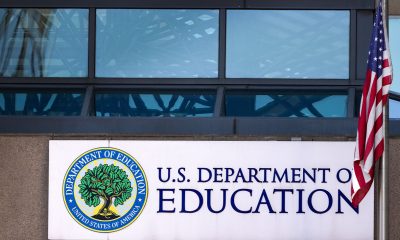#NNPA BlackPress
COMMENTARY: Education Department helps loan servicers instead of borrowers
NNPA NEWSWIRE — …a newly-released audit report finds fault with how the Department of Education (Department) is managing both its loan funds and its 15 contract student loan servicers. According to an Office of Inspector General (OIG) report released on February 12, “borrowers might not have been protected from poor services, and taxpayers might not have been protected from improper payments.”
By Charlene Crowell, NNPA Newswire Contributor
In an increasingly competitive global economy, highly skilled workers have a sharp advantage in securing and keeping employment. And as technological advances result in life-long learning in many occupations, many worker-students turn to federal student aid, the largest source of funding for higher education, to expand and/or hone their value in the marketplace.
But a newly-released audit report finds fault with how the Department of Education (Department) is managing both its loan funds and its 15 contract student loan servicers. According to an Office of Inspector General (OIG) report released on February 12, “borrowers might not have been protected from poor services, and taxpayers might not have been protected from improper payments.”
That statement covers a range of student loan concerns and include loan payments, loan consolidation, principal and interest payments and repayment options like income-driven repayment plans and forbearance. But its content takes direct aim at the Federal Student Aid (AID) division of the Department, charged with being a thrifty steward of the billions of dollars dedicated to higher education.
Could it be that the current student loan crisis is facing the same threat today that was rampant a decade ago during the mortgage crisis? Are borrowers’ payments being properly applied? Or are unchecked and unaccountable loan servicers bilking consumers into unwarranted costs and payments?
I’m betting that the 44 million borrowers who together owe more than $1.4 trillion in student loan debt seriously want to know.
“FSA’s not holding servicers accountable could lead to servicers being paid more than they should be (the contracts with servicers allow FSA to recover amounts paid for loans not serviced in compliance with requirements),” states the report.
“FSA management rarely used available contract accountability provisions to hold servicers accountable for instances of noncompliance,” continued the report. “By not holding servicers accountable for instances of noncompliance with Federal loan servicing requirements, FSA did not provide servicers with an incentive to take actions to mitigate the risk of continued servicer noncompliance that could harm students.”
According to OIG, all student loan servicer contracts are supposed to be awarded on the basis of performance measures in five weighted areas. Two factors, borrower satisfaction and the percentage of borrowers who were not more than five days delinquent, together account for up to 60 of the contractors overall score. Servicers are also evaluated on the percentage of borrowers whose loans were more than 90 days late but less than 271, and a percentage who were more than 270 days delinquent but less than 361, and an FSA employee satisfaction survey.
Although the Department has 15 student loan servicer contracts, four were the biggest beneficiaries during the OIG’s audit period. As of September 30, 2017, federal student loan debt was $1.147 trillion with 93 percent of those loans assigned to PHEAA ($319 billion), Great Lakes ($236 billion), Navient ($215 billion), and Nelnet ($180 billion).
In February 2017, the Consumer Financial Protection Bureau (CFPB) sued Navient Corporation and two of its subsidiaries for allegedly using shortcuts and deception to illegally cheat 12 million borrowers out of their rights to lower loan repayments. These practices, according to CFPB, led to an additional $4 billion in borrower costs.
Much of the unnecessary costs were the result of Navient’s widespread use of forbearance that boosted corporate profits by minimizing time spent advising distressed borrowers. For example, three-years of deferment on $30,000 in student loans would cost a borrower an additional $6,742.
Navient also had another dubious distinction. In 2017, more consumers filed complaints about Navient than any other student loan servicer. Complainants identified dealing with the servicer or lender as the key issue, compared to only 34 percent whose problems were based on an inability to pay their loans.
“The Inspector General’s damning revelations that the Department of Education failed to track all instances of non-compliance or to hold servicers accountable for errors demonstrates its lack of commitment to protecting student loan borrowers,”, said Persis Yu, director of the National Consumer Law Center’s Student Loan Borrower Assistance Project. “Unfortunately, this revelation is consistent with the Department’s prior actions, which have repeatedly put the interests of big business ahead of the interests of student loan borrowers.
Many consumer advocates would agree with the Trump Administration’s mounting actions that favor businesses before consumers. The recently-announced rule reversal on payday loans is another example. In 2018, guidance that protected people of color from discrimination in auto loan financing is yet another.
“Policies and practices must assure student success while minimizing costly debt errors that become unnecessary burdens,” said Whitney Barkley-Denney, a policy counsel with the Center for Responsible Lending.
“In this past year, Department of Education has justified its aggressive steps to shield student loan servicers from liability by claiming that it rigorously oversees its servicers,” added Yu. “This report from the Inspector General demonstrates that claim is false.”
Charlene Crowell is the Center for Responsible Lending’s communications deputy director. She can be reached at Charlene.crowell@responsiblelending.org.
#NNPA BlackPress
LIHEAP Funds Released After Weeks of Delay as States and the District Rush to Protect Households from the Cold
BLACKPRESSUSA NEWSWIRE — The federal government has released $3.6 billion in home heating assistance after a delay that left states preparing for the start of winter without the program’s annual funding.

By Stacy M. Brown
Black Press USA Senior National Correspondent
The federal government has released $3.6 billion in home heating assistance after a delay that left states preparing for the start of winter without the program’s annual funding. The Low-Income Home Energy Assistance Program, known as LIHEAP, helps eligible households pay heating and cooling bills. The release follows a shutdown that stretched 43 days and pushed agencies across the country to warn families of possible disruptions.
State officials in Minnesota, Kansas, New York, and Pennsylvania had already issued alerts that the delay could slow the processing of applications or force families to wait until December for help. In Pennsylvania, more than 300,000 households depend on the program each year. Minnesota officials noted that older adults, young children, and people with disabilities face the highest risk as temperatures fall.
The delay also raised concerns among advocates who track household debt tied to rising utility costs. National Energy Assistance Directors Association Executive Director Mark Wolfe said the funds were “essential and long overdue” and added that high arrearages and increased energy prices have strained families seeking help.
Some states faced additional pressure when other services were affected by the shutdown. According to data reviewed by national energy advocates, roughly 68 percent of LIHEAP households also receive nutrition assistance, and the freeze in multiple programs increased the financial burden on low-income residents. Wolfe said families were placed in “an even more precarious situation than usual” as the shutdown stretched into November.
In Maryland, lawmakers urged the Trump administration to release funds after the state recorded its first cold-related death of the season. The Maryland Department of Health reported that a man in his 30s was found outdoors in Frederick County when temperatures dropped. Last winter, the state documented 75 cold-related deaths, the highest number in five years. Rep Kweisi Mfume joined more than 100 House members calling for immediate federal action and said LIHEAP “is not a luxury” for the 100,000 Maryland households that rely on it. He added that seniors and veterans would be placed at risk if the program remained stalled.
Maryland Gov. Wes Moore used $10.1 million in state funds to keep benefits moving, but noted that states cannot routinely replace federal dollars. His administration said families that rely on medical equipment requiring electricity are particularly vulnerable.
The District of Columbia has already mapped out its FY26 LIHEAP structure in documents filed with the federal government. The District’s plan shows that heating assistance, cooling assistance, weatherization, and year-round crisis assistance operate from October 1 through September 30. The District allocates 50 percent of its LIHEAP funds to heating assistance, 10 percent to cooling, 13 percent to year-round crisis assistance, 15 percent to weatherization, and 10 percent to administrative costs. Two percent is used for services that help residents reduce energy needs, including education on reading utility bills and identifying energy waste.
The District’s plan lists a minimum LIHEAP benefit of $200 and a maximum of $1,800 for both heating and cooling assistance. Crisis benefits are provided separately and may reach up to $500 when needed to resolve an emergency. The plan states that a household is considered in crisis if it has been disconnected from energy service, if heating oil is at 5 percent or less of capacity, or if the household has at least $200 owed after the regular benefit is applied.
The District’s filing notes that LIHEAP staff conduct outreach through community meetings, senior housing sites, Advisory Neighborhood Commissions, social media, posters, and mass mailings. The plan confirms that LIHEAP applicants can apply in person, by mail, by email, or through a mobile-friendly online application and that physically disabled residents may request in-home visits.
As agencies nationwide begin distributing the newly released funds, states continue working through large volumes of applications. Wolfe said LIHEAP administrators “have been notified that the award letters have gone out and the states can begin to draw down the funds.”
#NNPA BlackPress
Seven Steps to Help Your Child Build Meaningful Connections
BLACKPRESSUSA NEWSWIRE — Swinging side by side with a friend on the playground. Sharing chalk over bright, colorful sidewalk drawings. Hiding behind a tree during a spirited game of hide-and-seek. These simple moments between children may seem small, but they matter more than we think

By Niyoka McCoy, Ed.D., Chief Learning Officer, Stride/K12
Swinging side by side with a friend on the playground. Sharing chalk over bright, colorful sidewalk drawings. Hiding behind a tree during a spirited game of hide-and-seek. These simple moments between children may seem small, but they matter more than we think: They lay the foundation for some of life’s most important skills.
Through everyday play, young children begin learning essential social and emotional skills like sharing, resolving conflicts, showing empathy, and managing their emotions. These social skills help shape emotional growth and set kids up for long-term success. Socialization in early childhood isn’t just a “nice-to-have”—it’s essential for development.
Yet today, many young children who haven’t yet started school aren’t getting enough consistent, meaningful interaction with peers. Research shows that there’s a decline in active free play and peer socialization when compared to previous generations.
There are many reasons for this. Children who are home with a parent during the day may spend most of their time with adults, limiting opportunities for peer play. Those in daycare or preschool may have restricted free play, and large classrooms can reduce supervision and social coaching. Some children live in rural areas, are homebound due to illness, have full schedules, or rely on screens to fill their playtime. And for some families, finding other families with young children to connect with isn’t easy.
While these challenges can feel significant, opportunities for connection still exist in every community. Families can take simple steps to help children build friendships, create a sense of belonging, and strengthen social skills. Here are some ideas to get started:
- Storytime sessions at libraries or local bookstores
- Community offerings such as parent-child workshops, art, music, gymnastics, swimming, or sports programs
- Weekly events at children’s museums, which may include art projects, music workshops, or science experiments
- Outdoor exploration, where kids can play with peers
- Local parenting groups that organize playdates and group activities
- Volunteer opportunities where children can participate, such as pet adoption events or packing meals at a food bank
- Classes for kids at local businesses, including hardware, grocery, or craft stores
Some of these community activities are free or low-cost and give kids the chance to build friendships and practice social skills. Parents can also model positive social behavior by interacting with other parents and encouraging their children to play with their peers.
These may seem like small moments of connection, but they can have a powerful impact. Every time your child shares a toy, plays make-believe with peers, or races a friend down the slide, they’re not just playing—they’re learning the skills that build confidence, empathy, and lasting friendships. And it’s good for you, too. Creating intentional opportunities for play also helps you strengthen your own network of parents who can support one another as your children grow together.
#NNPA BlackPress
Seven Steps to Help Your Child Build Meaningful Connections
BLACKPRESSUSA NEWSWIRE — Swinging side by side with a friend on the playground. Sharing chalk over bright, colorful sidewalk drawings. Hiding behind a tree during a spirited game of hide-and-seek. These simple moments between children may seem small, but they matter more than we think

By Niyoka McCoy, Ed.D., Chief Learning Officer, Stride/K12
Swinging side by side with a friend on the playground. Sharing chalk over bright, colorful sidewalk drawings. Hiding behind a tree during a spirited game of hide-and-seek. These simple moments between children may seem small, but they matter more than we think: They lay the foundation for some of life’s most important skills.
Through everyday play, young children begin learning essential social and emotional skills like sharing, resolving conflicts, showing empathy, and managing their emotions. These social skills help shape emotional growth and set kids up for long-term success. Socialization in early childhood isn’t just a “nice-to-have”—it’s essential for development.
Yet today, many young children who haven’t yet started school aren’t getting enough consistent, meaningful interaction with peers. Research shows that there’s a decline in active free play and peer socialization when compared to previous generations.
There are many reasons for this. Children who are home with a parent during the day may spend most of their time with adults, limiting opportunities for peer play. Those in daycare or preschool may have restricted free play, and large classrooms can reduce supervision and social coaching. Some children live in rural areas, are homebound due to illness, have full schedules, or rely on screens to fill their playtime. And for some families, finding other families with young children to connect with isn’t easy.
While these challenges can feel significant, opportunities for connection still exist in every community. Families can take simple steps to help children build friendships, create a sense of belonging, and strengthen social skills. Here are some ideas to get started:
- Storytime sessions at libraries or local bookstores
- Community offerings such as parent-child workshops, art, music, gymnastics, swimming, or sports programs
- Weekly events at children’s museums, which may include art projects, music workshops, or science experiments
- Outdoor exploration, where kids can play with peers
- Local parenting groups that organize playdates and group activities
- Volunteer opportunities where children can participate, such as pet adoption events or packing meals at a food bank
- Classes for kids at local businesses, including hardware, grocery, or craft stores
Some of these community activities are free or low-cost and give kids the chance to build friendships and practice social skills. Parents can also model positive social behavior by interacting with other parents and encouraging their children to play with their peers.
These may seem like small moments of connection, but they can have a powerful impact. Every time your child shares a toy, plays make-believe with peers, or races a friend down the slide, they’re not just playing—they’re learning the skills that build confidence, empathy, and lasting friendships. And it’s good for you, too. Creating intentional opportunities for play also helps you strengthen your own network of parents who can support one another as your children grow together.
-

 Activism3 weeks ago
Activism3 weeks agoOakland Post: Week of November 12 – 18, 2025
-

 Activism3 weeks ago
Activism3 weeks agoIN MEMORIAM: William ‘Bill’ Patterson, 94
-

 Activism3 weeks ago
Activism3 weeks agoHow Charles R. Drew University Navigated More Than $20 Million in Fed Cuts – Still Prioritizing Students and Community Health
-

 Bay Area3 weeks ago
Bay Area3 weeks agoNo Justice in the Justice System
-

 #NNPA BlackPress2 weeks ago
#NNPA BlackPress2 weeks agoLewis Hamilton set to start LAST in Saturday Night’s Las Vegas Grand Prix
-

 #NNPA BlackPress3 weeks ago
#NNPA BlackPress3 weeks agoThe Perfumed Hand of Hypocrisy: Trump Hosted Former Terror Suspect While America Condemns a Muslim Mayor
-

 #NNPA BlackPress2 weeks ago
#NNPA BlackPress2 weeks agoBeyoncé and Jay-Z make rare public appearance with Lewis Hamilton at Las Vegas Grand Prix
-

 #NNPA BlackPress3 weeks ago
#NNPA BlackPress3 weeks agoTrump’s Death Threat Rhetoric Sends Nation into Crisis
























































